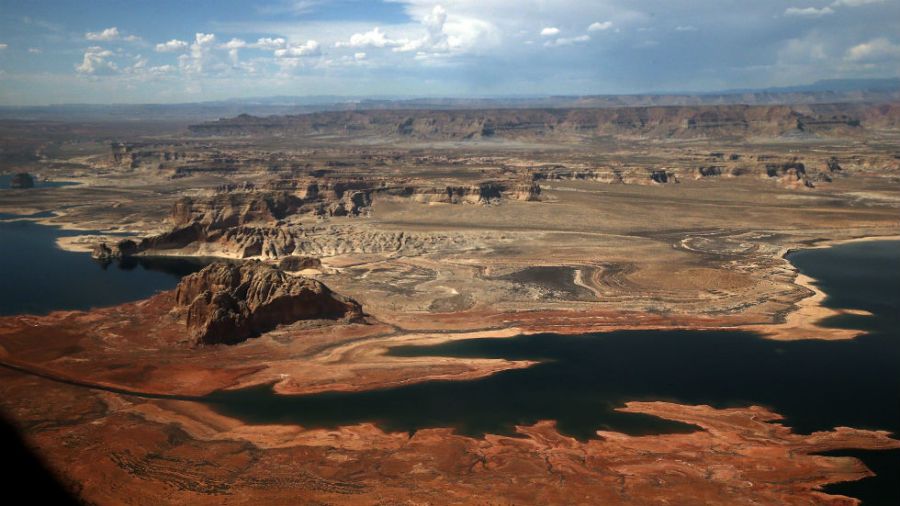Equilibrium — Deadly twisters threaten mobile homes
Equilibrium is a newsletter that tracks the growing global battle over the future of sustainability. Sign up here or in the box below.
The severe storms that struck the South this week — killing at least three — demonstrated the dangers of staying inside a mobile home during a tornado.
Most of the homes destroyed during the storm were either mobile or manufactured, while at least one of the deaths occurred in such a residence, according to The Weather Channel.
Three people died in Louisiana over the past few days, as twisters swirled through the state and as a broader storm system battered the country from coast to coast, our colleague Julia Mueller reported for The Hill.
One fatality occurred outside New Orleans, while a mother and son were found dead in northern Louisiana. Dozens of other residents were reportedly hurt, while some remain hospitalized with what Louisiana Gov. John Bel Edwards (D) described as “significant injuries.”
More than 1 in 5 tornado deaths in 2021 were tied to manufactured homes. Of the 104 tornado fatalities last year, 23 occurred in manufactured homes, The Weather Channel noted, citing data from the national Storm Prediction Center.
In 2020, about half — 39 of the 76 tornado deaths — occurred in such mobile structures. And through Nov. 30 of this year, more than half of tornado deaths — 13 out of 22 — were in these types of homes, according to The Weather Channel.
The threat of staying inside a manufactured building during a tornado is magnified in the southeastern U.S., as these homes are typically located far away from their neighbors, Stephen Strader, of Villanova University, told the outlet.
“They’re isolated on different plots of land by themselves or maybe with one or two other homes,” Strader, an assistant geography professor, said. “What that means is they’re 20, 30 minutes away from the nearest shelter.”
Welcome to Equilibrium, I’m Sharon Udasin. Today we’ll look at a historic decision on rooftop solar buybacks in California. Still out West, we’ll see how Upper Colorado River states will be paying water users to cut back on consumption. Plus: How whales could help the planet store carbon dioxide.
Californians to see cuts in rooftop solar paybacks

Californians who install rooftop solar systems will soon receive less payback for the electricity they sell to the grid following a contentious Thursday hearing at the state’s utilities commission.
Cutting back credit: The California Public Utilities Commission (CPUC) voted unanimously to approve a contentious proposal to revamp the state’s “net energy metering” solar tariff.
- The existing tariff has allowed Californian households to get credit on their electricity bills at retail rates and offset monthly energy expenses.
Reality versus retail: While existing solar producers will be able to maintain their current arrangements for 20 years, future customers will face stricter terms, according to the proposal.
- Industry experts say these measures could reduce net metering credit by anywhere between 75 and 80 percent.
- New customers will be subject to rates that are tied to how much electricity is worth at a given time of day.
- They’ll also need to pay a fixed monthly fee.
Incentives for storage, low-income customers: The CPUC would also harness an additional $900 million of state legislature-approved funding in upfront incentives for residential solar adopters who install battery storage.
Of that total, 70 percent — $630 million — will be set aside for low-income customers.
When would the shift occur? Changes to the billing systems at California’s three utilities will begin to take effect 12 months after Thursday’s vote.
But within 120 days of the decision — approximately April 2023 — new customers will no longer be able to participate in the previous net metering system.
A LONG-TERM BATTLE
The decision has long been a subject of contention among Californians, as we previously reported.
- Environmental groups have largely opposed the changes, arguing that these measures would slow California’s clean energy transition.
- “It’s devastating to see California, the nation’s shining solar leader, propose to dismantle solar incentives this Christmas,” Laura Deehan, of Environment California, said ahead of Thursday’s hearing.
And those in favor? Those pushing for change — including major utilities — argue the current system puts lower-income households at a disadvantage, as they are paying higher rates to offset the solar subsidy.
- CPUC wants to replace a system that “disproportionately harms low-income ratepayers, and is not cost-effective,” Administrative Law Judge Kelly Hymes wrote in the proposal’s introduction.
- The new tariff structure, according to Hymes, seeks to “promote equity, inclusion, electrification, and the adoption of solar paired with storage systems.”
Reorienting usage: On the eve of the hearing, Matt Baker, the director of the CPUC’s Public Advocates Office, also criticized current policy for encouraging the use of solar power during the day, in an op-ed for CalMatters.
While the price for electricity is currently about 5 cents per kilowatt-hour during the day, that figure can increase more than 20-fold at night, Baker argued.
Vulnerable and volatile: Both ahead of and following Thursday’s vote, CPUC received criticism far and wide about the terms of the proposal.
- Sean Gallagher, vice president of the Solar Energy Industries Association, said in a statement that the “abrupt” transition “threatens to slow the deployment of rooftop solar.”
- “This comes as climate-related disasters continue to intensify and the electric grid remains vulnerable to aging infrastructure and volatile global energy markets,” Gallagher added.
Check The Hill’s website later this evening to read more details about the changes.
Some Colorado River states to pay users to cut back

Four states in the upper basin of the Colorado River have announced they will temporarily conserve water from the river amid a historic Western drought, our colleague Zack Budryk reported.
Paying to conserve: The plan, unveiled by representatives of Colorado, New Mexico, Utah and Wyoming on Wednesday, will pay river users to voluntarily cut back on their use.
- The so-called System Conservation Pilot Program would pay participating users at least $150 per acre-foot of water conserved.
- The program is tentatively set to begin next April, with $125 million in funds from the Inflation Reduction Act.
Longer-term solutions needed: The Upper Colorado River Basin Commission, which is responsible for the program, touted the initiative as a step that will help “mitigate the water supply crisis in the Upper Colorado River Basin.”
- That crisis has been “brought on by a drier climate and depleted storage,” a statement from the commission said.
- The group acknowledged, however, that “longer-term and durable solutions are needed.”
Decades-long struggle: These conservation measures come as the U.S. West struggles with the impact of a two-decade drought on the Colorado River, Budryk reported.
- Use of the river’s waters is controlled by a century-old agreement that allocated states with more water than currently flows through it.
- Basin-wide shortages have decreased water levels at the nation’s two largest reservoirs, Lake Mead and Lake Powell, which also complicates hydropower generation.
Applications are open: The Upper Colorado River Commission released its first request for water-saving proposals on Wednesday, with a deadline of February, local NPR affiliate KUNC reported.
- Each participating state, along with the commission, will then be able to review the proposals, setting higher payout values on a case-by-case basis.
- The purpose of such a review is to discourage profiteering, the commission’s executive director, Chuck Cullom, told KUNC.
DROUGHT EMERGENCY DECLARED IN SOUTHERN CALIFORNIA
Officials in Southern California have declared a Regional Drought Emergency, as residents prepare to endure a fourth consecutive drought season.
Reducing use: The Metropolitan Water District urged residents on Wednesday to cut back on consumption and demanded that water agencies immediately reduce their use of imported water supplies.
- On average, the district imports about half of its water from the northern Sierra via the State Water Project and from the Colorado River.
- Some communities rely mostly on imported water.
Calls could become mandatory: The district’s board of directors warned that the call for conservation measures could become mandatory if drought conditions worsen.
“If we don’t have an extremely wet winter, we will need to elevate to our highest level — a water supply allocation for all of Southern California,” Adel Hagekhalil, general manager of the district, said in a statement.
Whales could help store planet’s carbon: study

Whales could play an invaluable role in the global effort to tackle climate change by using their massive girth to store carbon that would otherwise be polluting the atmosphere, a new study has found.
Massive potential: While much research on carbon storage has thus far focused on planting trees or restoring wetlands, the planet’s largest animals may also be worth significant attention, according to the study, published in Trends in Ecology and Evolution.
Whales, often the size of airplanes, can weigh up to 150 tons and live more than
100 years, the authors noted. And like all living things, their biomass is largely made up of carbon.
‘Largest living carbon pool’: These marine mammals “make up one of the largest living carbon pools in the pelagic ocean,” the authors stated, referring to the open waters located a distance from the shore.
- And that living carbon pool is “part of the marine system that is responsible for storing 22 percent of the Earth’s carbon,” according to the University of Alaska Southeast team.
- “Their size and longevity allow whales to exert strong effects on the carbon cycle,” the authors wrote.
Ocean-scale contributions: Whales can store carbon more effectively than smaller animals, as well as by “ingesting extreme quantities of prey” and generating large amounts of waste, the researchers noted.
- The baleen whale has one of the longest migration routes — meaning it can “potentially influence nutrient dynamics and carbon cycling over ocean-basin scales.”
- Blue whales, meanwhile, can live up to 90 years. When they die and their bodies crumble to the seafloor, the carbon they stored is transferred into the deep sea.
An important exchange: This activity contributes to what’s known as “the biological carbon pump” — a system in which nutrients and chemicals are exchanged between the ocean and the atmosphere, according to the study.
Population is dwindling: But commercial hunting has decreased the whale population by 81 percent, with unknown impacts on that system, the authors warned.
The full potential of whales to reduce carbon dioxide “will only be realized through robust conservation and management interventions that directly promote population increases,” they added.
To read the full story, please click here.
🚇 Thursday Threats
London’s Tube may be tainted with toxins, electric vehicles and crypto-mining may strain power supplies and Monsanto to pay for nine decades of pollution.
London Underground polluted with metals that can enter the human bloodstream
- The London Underground is polluted with ultra-fine metallic particles that are small enough to enter the human bloodstream, according to a new study in Scientific Reports. University of Cambridge researchers found high levels of a type of iron oxide in dust samples from ticket halls, platforms and operator cabins — but have yet to determine whether these metals pose a public health risk.
Electric vehicles, crypto-mining may pose threat to US power
- The use of electric vehicles and an increase in cryptocurrency mining could pose a threat to U.S. power reliability in the near future, the North American Electric Reliability Corporation told Reuters. These developments will add demand to the country’s fragile grid, while power plant closures could outpace the creation of new capacity, Reuters reported.
Monsanto to pay $698M for polluting Oregon
- Oregon Attorney-General Ellen Rosenblum announced on Thursday that Monsanto will pay $698 million for polluting the state over 90 years, according to CBS affiliate KPIC. Monsanto made, sold and distributed polychlorinated biphenyls — toxic compounds formerly used in coolants, electric equipment and other devices, KPIC reported.
Please visit The Hill’s Sustainability section online for more and check out other newsletters here. We’ll see you tomorrow.
Copyright 2023 Nexstar Media Inc. All rights reserved. This material may not be published, broadcast, rewritten, or redistributed. Regular the hill posts












